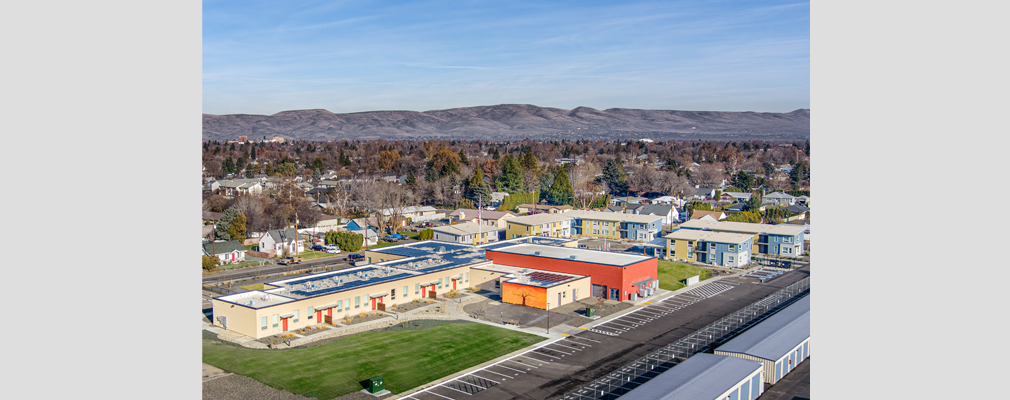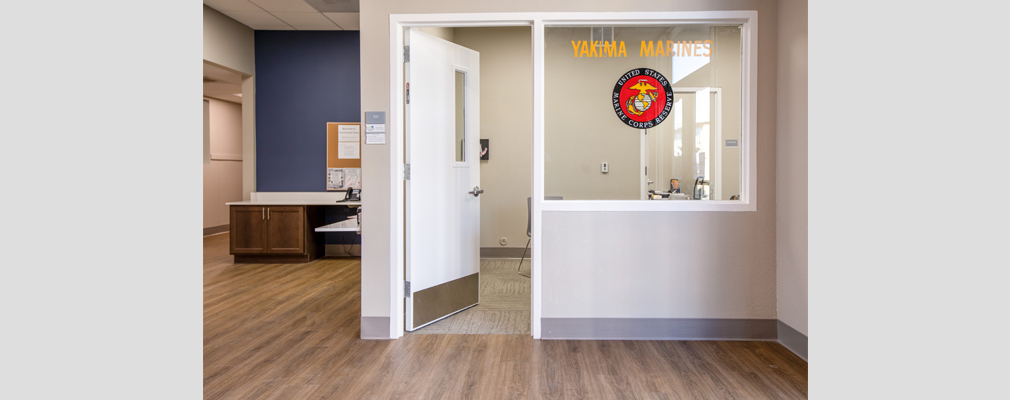Home > Case Studies > Yakima, Washington: An Adaptive Reuse Project Provides Supportive Housing for Formerly Homeless Veterans
Yakima, Washington: An Adaptive Reuse Project Provides Supportive Housing for Formerly Homeless Veterans
In recent years, the city of Yakima, Washington, has sought to address the needs of people, particularly veterans who are experiencing homelessness. The Yakima Housing Authority (YHA), in collaboration with key federal and local community partners, decided in 2016 to convert the longstanding United States Marine Corps armory into supportive housing for formerly homeless veterans and their families. The adaptive reuse project, made possible through the disposition of surplus federal property by the U.S. Department of Health and Human Services, was realized in 2021 as Chuck Austin Place, offering 41 units of affordable rental housing in several configurations designed to meet the comprehensive needs of veterans experiencing homelessness and their families. The redeveloped site includes ample space for area service providers, including Yakima Neighborhood Health Services (YNHS). Chuck Austin Place also includes common spaces that integrate the development into the surrounding area and make it a community asset. The development is named after beloved local veteran Chuck Austin, who served in three different wars during his decades-long service to the country.
Chuck Austin Place
Chuck Austin Place's 41 apartments include 14 studios, 17 one-bedroom units, and 10 two-bedroom units. The studios are housed in the renovated armory structure, and the remaining units are located in five newly constructed buildings on the north and east sides of the 4-acre site. The new buildings are compatible in scale with structures in the surrounding neighborhood. A total of 21 units are available to households earning up to 30 percent of the area median income (AMI), 5 are set aside for those earning up to 40 percent of AMI, and 15 are reserved for those earning up to 60 percent of AMI.
The site's spacious common and community areas support the project's mission to provide supportive services for formerly homeless veterans and their families. Chuck Austin Place features 12,000 square feet of space for supportive services, of which YNHS occupies 1,500 square feet in the east wing of the renovated armory. YNHS spaces include two medical exam rooms, two dental procedure rooms, a lab, a reception area, and an office that dental and medical staff share. YNHS shares its waiting room with other service providers that visit Chuck Austin Place to meet the needs of people experiencing homelessness in the area. Additional common spaces include a dog run, a raised-bed garden, a veterans' memorial, a reflection space, a hygiene center, a resident library and community room, and a basketball court. The development includes energy-efficiency features, such as solar panels, ENERGY STAR® appliances, low-flow plumbing fixtures, and LED lights.
Converting Underutilized Federal Property
The project required the close collaboration of many federal and local partner organizations. YHA acquired the armory in 2017 after it applied to the U.S. Department of Health and Human Services to obtain the property under Title V of the McKinney-Vento Homeless Assistance Act. According to Lowel Krueger, YHA's executive director, the project "originated from Yakima stakeholders who saw the increasing need for housing and services for veterans in the community. The availability of this federal surplus armory property became an opportunity to develop this project to meet the need." YNHS, which operates Chuck Austin Place as a community health center, lobbied state and federal officials about the need for a healthcare facility that serves the needs of veterans experiencing homelessness.
YHA and partner Beacon Development Group opened Chuck Austin Place in 2021. According to Ashleigh Kilgore, housing developer for YHA, the armory's redesign required some creative modifications to the placement of beams and exterior insulation, but adapting the existing space was straightforward. Chuck Austin passed away before the project's completion but was present for the groundbreaking in 2019.
Services for Veterans and the Community
YNHS anchors the development's onsite social services. Its newly constructed space consists of a dental clinic as well as office spaces for health and behavioral health services for residents and community members. Chuck Austin Place has nine YHA staff members, including a resident site manager and two resident services coordinators along with six community services staff members and YNHS personnel supporting the dental clinic. Other community support services are available through Blue Mountain Action Council, the American Legion, and the Veterans of Foreign Wars. According to Kilgore, community members have donated clothes, furniture, household goods, and food for Chuck Austin Place residents, who are referred to the development through the Yakima County Veterans Program, YNHS, and the U.S. Department of Veterans Affairs. According to Rhonda Hauff, chief executive officer for YNHS, Chuck Austin Place advances the organization's goal of reducing health barriers for veterans in the community. One way that services staff accomplish this goal at Chuck Austin Place is by using smartphones to increase residents' digital literacy about healthcare services, including telehealth services. Residents have 21 project-based Section 8 vouchers and 20 project-based HUD-Veterans Affairs Supportive Housing vouchers for their apartments.
Financing
The $16.5 million project was realized largely through federal low-income housing tax credits and funds from the state. Funding for the solar panels at Chuck Austin Place came from Pacific Power's Blue Sky grant program and federal solar energy tax credits.
Table 1. Financing for Chuck Austin Place
| Low-income housing tax credit equity | $9,328,085 |
| Washington state housing trust fund | 2,002,057 |
| Deferred developer fee | 135,817 |
| HOME Investment Partnerships Program (through city of Yakima) | 1,100,000 |
| Federal Home Loan Bank of Des Moines | 750,000 |
| Washington State Department of Commerce Community Facilities grant | 2,500,000 |
| Washington State Department of Commerce Dental Facility grant | 459,620 |
| Pacific Power Blue Sky grant | 156,623 |
| Federal solar energy tax credits | 67,798 |
| Total | $16,500,000 |
Serving Veterans
Early evidence from Chuck Austin Place suggests that the community's onsite supportive social services have met the needs of veterans formerly experiencing homelessness. In 2023, for example, YNHS provided medical, dental, and enabling services in 945 visits for 495 patients. According to Hauff, Chuck Austin Place has helped build trust between service providers and veterans that extends to its other projects. "Because of YNHS' role at Chuck Austin Place as well as our role in the community in service to veterans — outreach efforts that take us where veterans are — there is recognition that helps our organization and all 10 primary care sites [be] seen as a more welcoming organization for veterans," said Hauff. One example of how YNHS has realized this services partnership has been through its deployment of a veteran to serve as an onsite community health worker who helps residents navigate healthcare and other community services. Creating such a welcoming place for veterans pays tribute to the project's namesake.
Anchor Institutions
- U.S. Virgin Islands Nonprofit Helps Community Focus on Disaster Recovery and Resiliency
- A Model for Community-Based Policing in Pittsburgh
- Click here for more
Community Development
- Scattered-Site Rehabilitation Pilots New RAD Section 18 Blend in Springfield, Missouri
- In Iowa, Efficient Design Turns a Vacant Lot Into Affordable Single-Family Housing
- Click here for more
Senior Housing
- Former School in Charleston, South Carolina, Transformed into Affordable Housing for Seniors
- Richmond, California: Rehabilitation of Vacant Public Housing Site Preserves Senior Housing
- Click here for more
Supportive Housing
- Yakima, Washington: An Adaptive Reuse Project Provides Supportive Housing for Formerly Homeless Veterans
- Village on Mercy Provides Supportive Housing in Orlando, Florida
- Click here for more
Sustainable Housing
- Pacific Landing Provides Energy-Efficient Affordable Housing in Santa Monica, California
- Innovative Solar Technology Powers Affordable Housing in River Falls, Wisconsin
- Click here for more
Zoning for Affordable Housing
This article was written under contract with the U.S. Department of Housing and Urban Development. The contents of this article are the views of the author(s) and do not necessarily reflect the views or policies of the U.S. Department of Housing and Urban Development or the U.S. Government.



